Every day, we, as athletes, dedicate precious time in the gym with the goal of improving our current self. Even if it is 45 minutes slammed in the middle of our busy work day, the time spent in the gym is sacred. Any fitness article, magazine, or headline that you read will bombard you with exercises you “should” be doing or routines you “should” be following. But have you ever asked yourself if your body is capable of performing these programs or exercises?
Every day, we, as athletes, dedicate precious time in the gym with the goal of improving our current self. Even if it is 45 minutes slammed in the middle of our busy work day, the time spent in the gym is sacred. Any fitness article, magazine, or headline that you read will bombard you with exercises you “should” be doing or routines you “should” be following. But have you ever asked yourself if your body is capable of performing these programs or exercises?
Placing strenuous exercise on a malfunctioning system is a recipe for injury, but how do we know what, if anything, is functionally wrong with us? The key to identifying these issues lies within your posture. Evaluating your posture can identify tight musculature, unbalanced strength within the system, and the causes of persistent pain. The good news is that even if you have a malfunctioning system, it can be fixed. You need to have a trained eye, functional know-how, and the patience to rebuild your fundamental mechanics. Does that sound easy?
The odds are that without the proper help, you will not be able to successfully fix yourself. For one, most do not have the proper physiological understanding of the body. Secondly, it is near impossible to fix what feels, for all intensive purposes, “natural” to you.
There Is Hope to Fix Your Mechanics
Although I cannot provide you with trained eye (unless you want to fly me out—I love to travel), I can provide you with the functional know-how to assess and correct your current posture. All you need to bring to the table is your unbeatable mind and the agreement that you will push the limits of your patience.
First, we must identify what proper posture looks like. Da Vinci’s Vitruvian Man provides a great glimpse into the inner workings of the human body. His work is a quintessential depiction of balance—and that is what perfect posture always boils down to at its purest form. Static posture must be balanced within the sagittal plane (right versus left) as well as the coronal plane (front versus back). Disruption within these planes causes imbalances that beget dysfunction and eventually cause pain.
The skeletal and muscular systems play the largest role within the body regarding posture. The following instruction will focus on the muscular system, as that is the only system of the two in which you can make a functional change. Our muscular system creates postural imbalances due to range of motion issues and unbalanced strength/activation between opposing muscles (think quads versus hamstrings). With most people, believe it or not, this stems from strength imbalances, not true range of motion issues.
It is vitally important from here on out to understand that your muscles never truly “turn off.” Your body simply remodels your motor patterns to compensate for poor postural habits. If you sit down all day, odds are your hip flexors are tight which then wreaks havoc on your ability to use your glutes properly. This pattern of equal and opposite will repeat itself over and over.
Now, let’s build your posture from the ground up.
Feet and Knees: Proper Posture and Fixing Overpronation
Feet should be parallel to each other when standing. Big toes should be firmly planted into the ground with the arch of your foot rigid and stacked off the floor. Your knees should be stacked over the midline of your foot.
Improper foot posture is seen primarily when your toes are turned out. Turned out toes are an easy indictor of ROM issues and underuse within your posterior hip muscles (gluteus) as well as tight, overactive anterior musculature (quads, psoas, TFL, and adductors).
Left: Correct Foot Position, Right: Incorrect Foot Position
Standing with your toes turned out also leads to the knee aligning over the inside of the foot. This is known as Pronation Distortion Syndrome and often leads to foot issues such as plantar fascitis. It also compromises the ACL in the knee.
I’ve used a simple trick with several athletes to help alleviate this problem. I will place two 25lb plates on the outside of the athlete’s feet and then have them actively press the sides of their feet into the plate. After a few seconds the athlete should feel the sides of their hips begin to burn a bit (“turn on”). I’ll start an athlete with this in a static position for 4 sets of 10-30 second holds. Add time as they get more confident and comfortable with this activation movement. You can have the athlete progress this by performing body weight squats while pressing into the plates. Always make sure their foot stays flat on the floor and their big toes do not come off the ground. I have seen this process take 3-4 weeks of practice before it starts to take hold in more higher intensity settings, like during a workout for example.
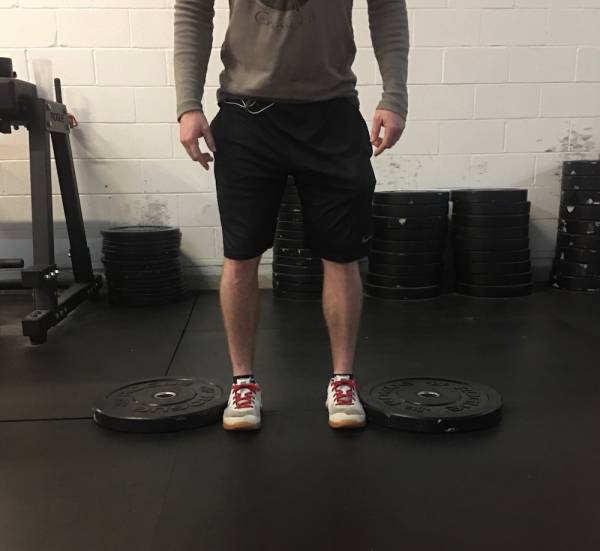
The Hips: Proper Posture and Fixes for Hip Imbalance
Your hips first should have equal weight distribution across both feet. Your gluteus muscles and lower abdominals should be equally engaged in order to properly set the lumbar spine.
A very common problem is seen in athletes who commonly shift weight primarily to one foot when standing. This is called asymmetrical weight distribution. This weight shift can cause the hips to be improperly engaged during movements. You’ll notice the imbalance if they trouble lunging on a particular leg or if their hips shift to the side during squats and deadlifts.
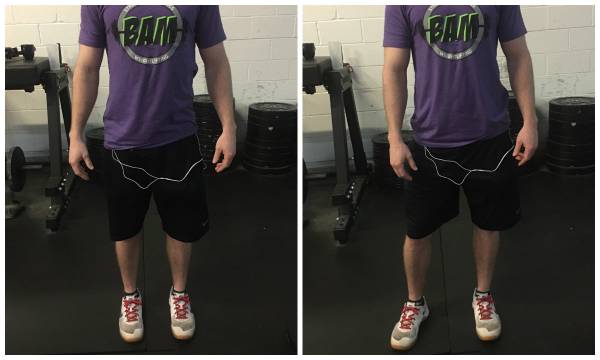
Left: Correct Hip Position; Right: Incorrect Hip Position
Another common problem is anterior pelvic tilt/lower cross syndrome. This is seen in approximately 70% of the population. It arises from overactive/tight anterior musculature and under activation of the posterior musculature of the hips in addition to nonexistent lower abdominal engagement.
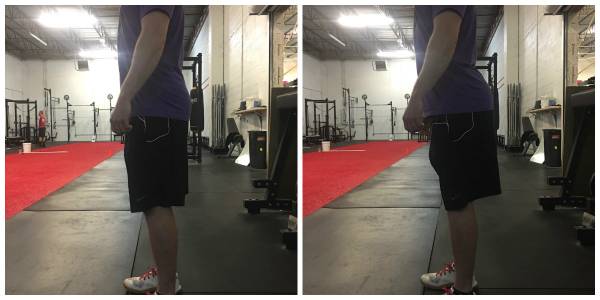
Left: Correct Pelvic Tilt; Right: Incorrect Pelvic Tilt
To fix asymmetrical weight distribution, constant reminders can be used, either verbally from a coach or intrinsically by the athlete, to correct their own weight distribution over and over.
To fix anterior pelvic telt, include the “dead-bug” exercise into your daily warm up routine. It is the best way I have found to correct an anterior pelvic tilt. It engages your lower abdominals and helps you to learn how a neutral spine feels. I cue my athletes to press their belly button into the ground when performing the dead-bug. As with the standing plate exercise above, we progress athletes from 10 seconds up to a 30 second hold. From there, you can progress the athletes by having them move their limbs while keeping the lower abdominals engaged into the floor.
The Shoulders: Proper Posture and Upper Cross Syndrome Fix
Your scapula (shoulder blade) should sit flush against the backside of your rib cage with your lower traps and lats engaged to keep your scapula from rounding forward. Moreover, your hands should rest with your thumbs facing forward and your arms by your sides.
Upper Cross Syndrome is a combination of tight anterior musculature and weak/disengaged posterior musculature. Sound familiar? Tight, overused pectoral muscles internally rotate our shoulders, and our weak lower traps and lats cannot pull the scapula down back into its normal place.
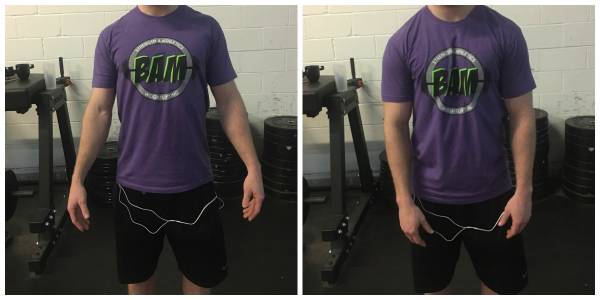
Left: Correct Shoulder Positioning; Right: Incorrect Shoulder Positioning
In addition, athletes who engage in CrossFit (most specifically) tend to compound this issue with the high volume of cleans and snatches. Overuse of the upper trap, used during shrugging movements, will amplify existing shoulder issues often leading to Shoulder Impingement Syndrome.
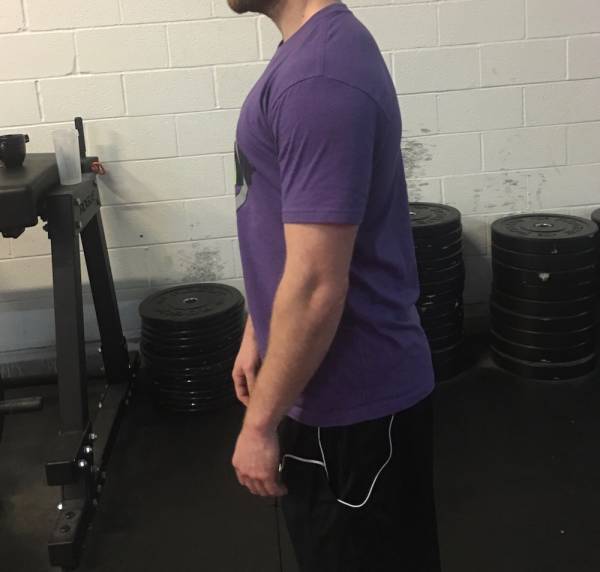
In order to retrain the scapula we must first develop awareness and then strengthen the appropriate musculature. My favorite drill for upper back postural awareness is the “Belt Pull-down Drill.” The video demonstration is below.
Similar to the above exercises mentioned, we start athletes with a handful of holds lasting around 10 seconds. We progress them up to 30 seconds and add movements like a basic hip hinge into the mix. This will increase the athlete’s postural awareness during moves like the deadlift or power clean.
Spend the Time Fixing Poor Patterns
When you move correctly you have to do less in the gym to achieve more results. I cannot recommend highly enough setting aside the 5-10 minutes daily to ingrain these movement patterns into your neurological system. Once they become second nature you can back off and complete these as neural cueing drills on applicable days (shoulder girdle on overhead heavy days or dead-bugs on lower body heavy days). However, it can never hurt to truly master the basics of human motion, especially when striving for elite levels of fitness.






